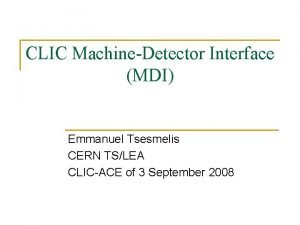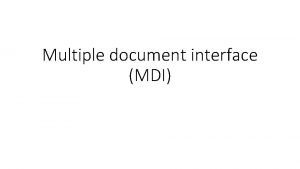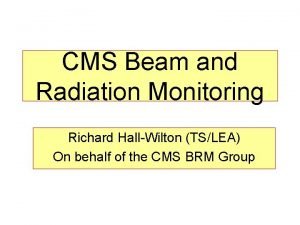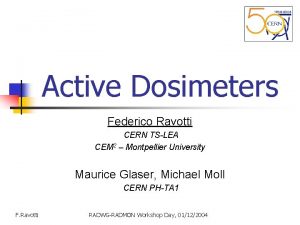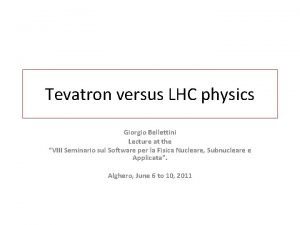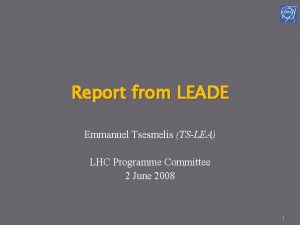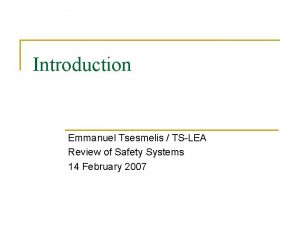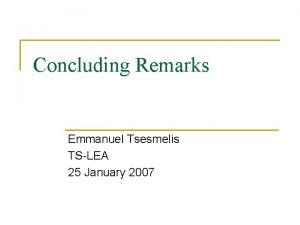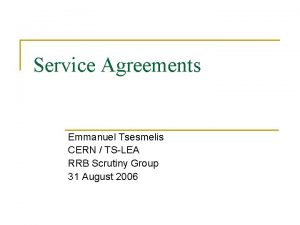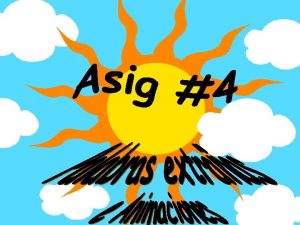Introduction Emmanuel Tsesmelis TSLEA 6 th LHC Radiation









- Slides: 9

Introduction Emmanuel Tsesmelis / TS-LEA 6 th LHC Radiation Workshop 29 -30 November 2007

General Remarks n LHC Technical Co-ordination Committee concluded in 1997 to install technical equipment in the LHC tunnel and various underground service areas. q Particularly under the arcs magnets. q Technical equipment should be located in these areas following suitable testing. n Assuming that the radiation levels will be kept to a dose of < 1 Gy/yr. in the area around the main dipoles. q n n In any superconducting collider local losses must stay below the quench limit in the superconducting magnets. A radiation monitoring system deployed which is adapted to the needs of the radiation tolerance understanding from the LHC start-up. Radiation effects on detectors have been understood as a major problem for the high luminosity experiments from the earliest days.

Radiation Tolerance n Radiation tolerance studies of technical equipment have thus been in progress for the LHC Project since 1997. q Great progress has been made in our understanding. n n Dose rates can often be kept to below 1 Gy/yr. However, modern electronics have an increased risk to instantaneous radiation-induced failures. q Due to high density of components on modern electronics § Increased sensitivity to relatively low-level of particle flux.

LHC Radiation Test Facility – SPS North Area Plus a number of other irradiation facilities both within and outside CERN

Particle Flux - LHC Operations n Simulations have shown that particle flux in specific areas around the LHC can be too high and can vary strongly with machine operating conditions. q q Particularly instantaneous rates during accidental beam losses. Subsequent updated simulations based on the vacuum conditions, beam loss rates and cleaning inefficiencies at the LHC have generally increased the predicted radiation levels. n For example, beam cleaning giving losses in IR 7 and collisions in IR 1 and IR 5.

LHC Radiation Workshops n A series of workshops have thus been held over several years. q The principal aims of the workshops were n to report on the verification of radiation tolerance of technical equipment and the development of various radiation monitoring devices for the measurement of the radiation field in LHC machine tunnel, underground areas and experiments, for the protection of personnel and technical equipment.

RADECS n RADECS Association – Radiation and its Effects on Components and Systems q q Interfacing experts from industry, scientific organisations and universities. Objectives: n n n Promote basic and applied science and more specifically research in the field of radiation and its effects on materials, components and systems. Relevant industries: space and nuclear industries. http: //www. radecs. org

Conclusions and Outlook n n Expertise and know-how in radiation-tolerant design and radiation testing has improved significantly over the last few years. Equipment groups have been made aware of radiation hazards. However, many uncertainties & risk areas remain: q Not all components have been radiation-tested. q How accurate are the simulations? A great deal of interesting and crucial work remains to be done to ensure that radiation effects do not make LHC commissioning and operation even more difficult than expected. q As a result of frequent technical equipment in the tunnel, service areas and experimental areas.

Conclusions and Outlook n Expertise needs to be maintained in order to be prepared when problems in the field will arise. q n Radiation-related issues observed at CNGS, RHIC and Tevatron are worrisome. Collaboration with the LHC experiments, space agencies and other labs with similar radiation tolerance problems remains very important.

